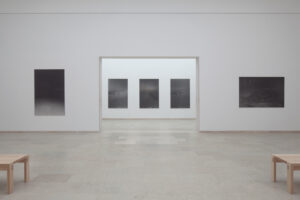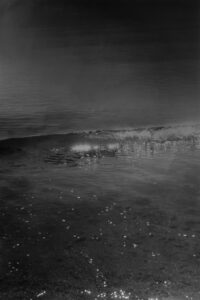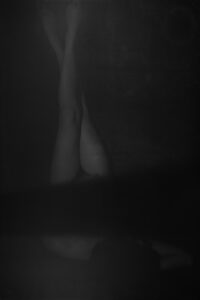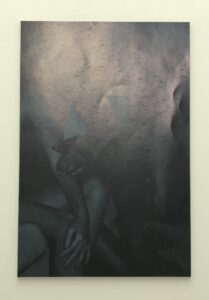
The vast white interior of the Belgian pavilion at the Giardini site of the Venice Biennale has a calming, almost hypnotizing, effect on those who enter. For the 57th Venice Biennale The Flemish Minister Sven Gatz commissioned the photographer Dirk Braeckman to represent Belgium at the 57th Venice Biennale. The curator of the exhibit is Eva Wittocx. The exhibit itself consists entirely of photographs taken by Breakman, which depict various scenes, some with a clear human presence and subject, others without. The pictures are all printed in large format in deep gray tones, hung alone or as part of two and three painting series.
Braeckman’s photographs appear as dark voids against the walls of the pavilion’s interior upon first glance. The pictures themselves are incredibly intimate and still. The darkness of the medium softens any harsh lines the images have to offer, muting most emotions of the pictures and creating a general sense of tranquility in the images. Many of the images and forms in the photographs are hard to decipher unless the viewer approaches the photograph and stands quite near to study it, which creates an intimate experience for the viewer. Upon closer exploration, forms appear: women’s legs and hands, curtains, rugs, windows, doors, entire human figures, and sparkling water. When viewing these photographs, I almost felt that they were familiar to me; as if I were there when they were taken, standing beside the photographer. The intensely personal relationship I felt to these pictures was unlike any other experience I have had looking at a work of art.
The figures in the photographs appear entirely anonymous. There are no wall didactics to provide information on any of the pictures or the subjects. Few of the pictures are placed in a series and appear in direct conversation with each other. On the back wall, there is a set of pictures of water, which evokes a sense of concentration and thought on behalf of the photographer. He seems to be mulling over and musing the ocean tide and the different ways light reflects off the water. In turn, I found myself also contemplating the peacefulness of the ocean, the interplay between the light and water, and the soft curl of the waves. Again I was struck by the sense of stillness the pictures evoked, despite clearly catching a time of turbulent movement and change.

However, no other pictures in the gallery were placed in such a purposeful relationship. The pictures of windows and doors do not appear to be a part of the same house. There are multiple pictures of women, some with their entire figure pictured, others just fragmented body parts, but I didn’t get the sense that any of them were of the same woman. The photographs, and those pictured in them, are remarkably unattached to any form of a narrative. Even in the photo where the figures of several women are pictured sitting next to each other, there is no anecdote suggested by their presence. I believe this lack of any story or history behind any of the pictures, as well as the collection of photographs as a whole, is a very unique phenomenon that the exhibition achieves. As someone who enjoys learning the stories behind works, and creating narratives of relationships behind collections of photographs, I found it strange that I did not seek something further from these pictures—a story, a plotline, even a secret relationship between two of the figures pictured. Each picture is remarkably fulfilling as a work of art in a way that the viewer doesn’t need anything more from it. I was content with the still beauty and form the photographs presented. Bodies did not appear to me as sexualized objects or meant to represent a hidden relationship to the photographer. The photographs seemed so present with a touch of ephemeral timelessness that they appeared independent of the sequence of time—they could have been taken at any time, anywhere, of anyone.

The photographs appear temporary yet eternal in way that draws intense attention to the medium of photography. A camera’s ability to capture a momentary instant in time and preserve it perfectly for a greater period of time is unique to the medium of photography. The lines of sunlight in drapes and windowpanes captured by the camera reveal the transitory nature of the pictures. Even further, the flash of the camera reflects off of the water and a shimmery satin skirt, drawing attention to the use of the device. One picture, which Breackman unapologetically offers to the viewer, is nearly engulfed in glare from the camera. He appears to be embracing, rather than rejecting, the camera’s technological difficulties. He also, in my opinion, seems to be subtly commenting on a camera’s ability to perfectly render scenes with exact truthfulness.

I greatly enjoyed this pavilion. It was a welcome break from the bustling urban environment and some of the more fantastical and intense pavilions at the biennale. That is not to say, however, that it was devoid of thought-provoking material. To me, it seemed to be a wonderful example that art does not need to be incredibly argumentative and controversial to produce a captivating experience and profoundly explore an idea or message.
Hi Lucy, great post! What about these images made you feel like they were familiar? I enjoy your commenting on the juxtaposition between these seemingly familiar figures and the knowledge that no information was given on who these figures are. I like that you found meaning within the lack of structure of the exhibit. I also found this to be true. Additionally, I thought the “white cube” space the works existed in were highly conductive for the works, giving them the full focus and a subtlety coherent throughout the pavilion. I’m curious as how past artists works inhabited this space. It is also interesting that the medium of photography was not explored greatly in other pavilions. This seems to be the only one that purely centers around this particular medium. Even still, there was extreme depth evident here that moved this space beyond a typical photography show, one I greatly enjoyed as well.